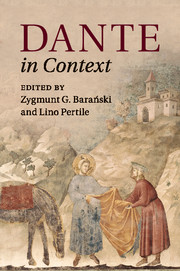Book contents
- Frontmatter
- Dedication
- Contents
- List of illustrations
- List of maps
- Notes on contributors
- Chronology
- Abbreviations and note on translations
- Introduction
- Part I Politics and society
- Part II Intellectual traditions
- Part III Linguistic and literary cultures
- Part IV Visual and performative culture
- Part V Dante: life, works, and reception
- 27 Life
- 28 Works
- 29 Textual transmission
- 30 Early reception (1290–1481)
- Further reading
- Index
30 - Early reception (1290–1481)
from Part V - Dante: life, works, and reception
Published online by Cambridge University Press: 05 October 2015
- Frontmatter
- Dedication
- Contents
- List of illustrations
- List of maps
- Notes on contributors
- Chronology
- Abbreviations and note on translations
- Introduction
- Part I Politics and society
- Part II Intellectual traditions
- Part III Linguistic and literary cultures
- Part IV Visual and performative culture
- Part V Dante: life, works, and reception
- 27 Life
- 28 Works
- 29 Textual transmission
- 30 Early reception (1290–1481)
- Further reading
- Index
Summary
Around the middle of the fifteenth century, on the verso of the opening page of his compilation of materials relating to Dante (Florence, Biblioteca Laurenziana ms. 90 sup. 131), the Florentine ser Piero Bonaccorsi (1410–77) copied two anecdotes that record a degree of hostility towards the poet. The first tale is constructed around the idea that ‘Dante is a knave [villano] … because he has said everything worth saying … and has left nothing for others to say’ while the second recounts Dante's ‘anger’ at a ‘rival’ who belittles his achievements. Yet Bonaccorsi's admiration for the poet was profound, not least because by the 1440s the cult of Dante's intellectual and artistic, as well as civic achievements was deeply rooted in Florence's culture. Bonaccorsi not only copied Dante's works and other texts associated with the poet, but also composed Il cammino di Dante (Dante's Journey, c.1440), which offered a careful literal summary of the Commedia and examined with illustrations the topography of Dante's afterlife – the latter a peculiarly Florentine interest – and a brief treatise on the poem's references to time. Nevertheless that ‘knave’, even if interpreted antiphrastically, given its association with the vignette of Dante irascibly defending his ‘fame’, and given the anecdote's strategic position in the manuscript, cannot but cast a shadow over ser Piero's appreciation. It hints at the complexity, ambiguity, and contradictoriness of Dante's reception in his native city – and indeed in the rest of Italy. On account of the extraordinary success of the Commedia and his widely acknowledged status as exceptional vernacular poet, thinker, and all-round exemplary individual, recourse was regularly made to Dante in literary, linguistic, cultural, and political disputes. Thus in Florence, since the latter part of the fourteenth century, the poet had become a touchstone in quarrels between defenders of the vernacular and humanist polemicists who decried the quality of his Latin and the gaps in his knowledge of the ancient world. Furthermore, by the 1430s such arguments had taken on increasingly political hues since they pitted pro-vernacular intellectuals, most notably Francesco Filelfo (1398–1481), close to the city's ruling oligarchy against classicizing supporters of the ever-more powerful Cosimo dei Medici (1389–1464).
- Type
- Chapter
- Information
- Dante in Context , pp. 518 - 537Publisher: Cambridge University PressPrint publication year: 2015

